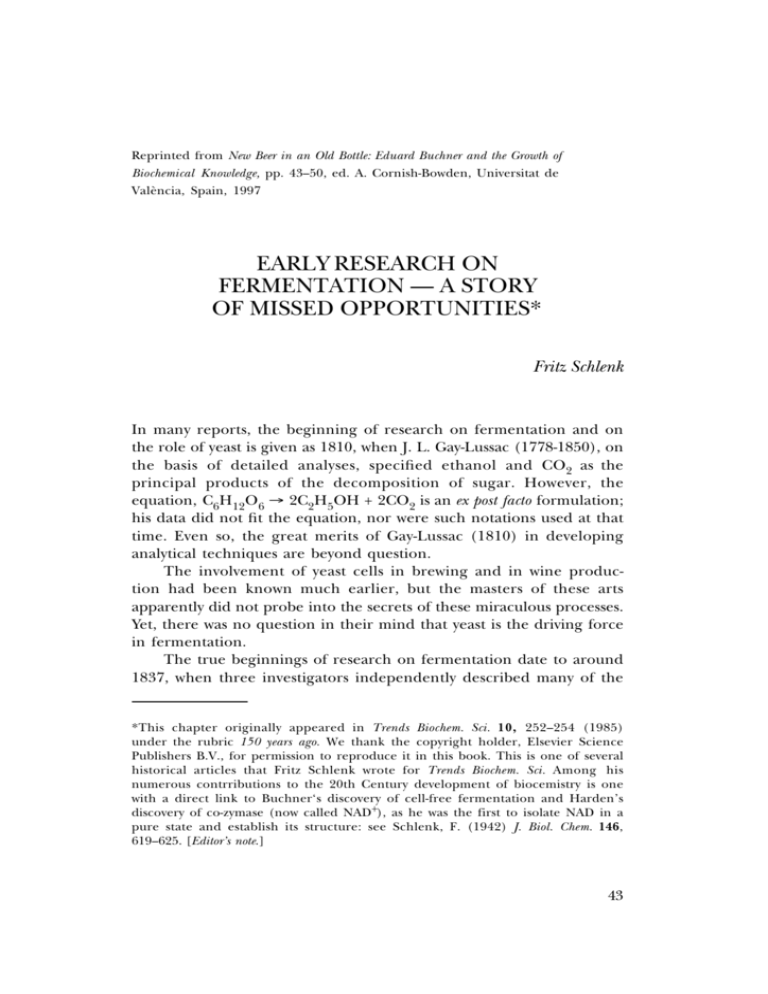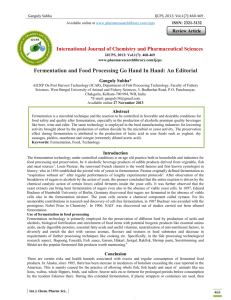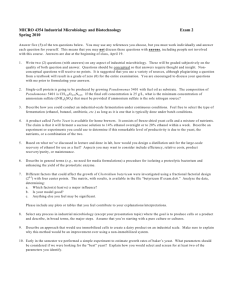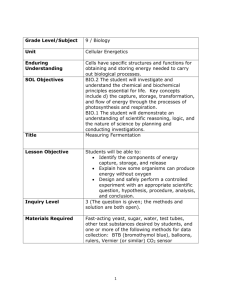Reprinted from New Beer in an Old Bottle
advertisement

Reprinted from New Beer in an Old Bottle: Eduard Buchner and the Growth of Biochemical Knowledge, pp. 43–50, ed. A. Cornish-Bowden, Universitat de València, Spain, 1997 EARLY RESEARCH ON FERMENTATION — A STORY OF MISSED OPPORTUNITIES* Fritz Schlenk In many reports, the beginning of research on fermentation and on the role of yeast is given as 1810, when J. L. Gay-Lussac (1778-1850), on the basis of detailed analyses, specified ethanol and CO2 as the principal products of the decomposition of sugar. However, the equation, C6H 12O 6 ! 2C2H 5OH + 2CO2 is an ex post facto formulation; his data did not fit the equation, nor were such notations used at that time. Even so, the great merits of Gay-Lussac (1810) in developing analytical techniques are beyond question. The involvement of yeast cells in brewing and in wine production had been known much earlier, but the masters of these arts apparently did not probe into the secrets of these miraculous processes. Yet, there was no question in their mind that yeast is the driving force in fermentation. The true beginnings of research on fermentation date to around 1837, when three investigators independently described many of the *This chapter originally appeared in Trends Biochem. Sci. 10, 252–254 (1985) under the rubric 150 years ago. We thank the copyright holder, Elsevier Science Publishers B.V., for permission to reproduce it in this book. This is one of several historical articles that Fritz Schlenk wrote for Trends Biochem. Sci. Among his numerous contrributions to the 20th Century development of biocemistry is one with a direct link to Buchner‘s discovery of cell-free fermentation and Harden’s discovery of co-zymase (now called NAD+), as he was the first to isolate NAD in a pure state and establish its structure: see Schlenk, F. (1942) J. Biol. Chem. 146, 619–625. [Editor’s note.] 43 SCHLENK principal features of yeast: Cagniard-Latour (1837) in France, and Schwann (1837) and Kützing (1837) in Germany. Microscopic studies were the key to their scientific conclusions. Charles Cagniard-Latour (1777–1859) was an accomplished physicist and engineer; his study of fermentation was the only excursion into the realm of biology. The importance of the problem had been impressed upon him by the fact that the French Academy of Sciences in 1779 had posted a prize of one kilogram of gold for a solution of the mystery of fermentation. Unfortunately, the offer had to be withdrawn in 1793, because of the political developments during that year, but Cagniard-Latour’s inquisitive spirit was undaunted by the cancellation of this inducement. He described the features of yeast cells, classified them as plants, observed the process of budding and noted the differences in shape between wine- and beer-yeasts. He also found that multiplication of the cells required nitrogenous material in addition to fermentable carbohydrate. The number of compacted cells per cm3 was noted to be at least 109, and their diameters 6–7 µm. The editorial committee of the Academy of Sciences (Thénard, Becquerel and Turpin) praised Cagniard-Latour’s work highly (Turpin, 1838) and encouraged him to continue. Unfortunately, however, he reverted to his research interests in physics. Theodor Schwann (1810–1882) was trained in medicine and did his early research in the department of the physiologist J. Müller in Berlin. One of his early accomplishments was the discovery of pepsin. His study of fermentation (Schwann, 1837) is remarkable in several ways. He showed that living yeast cells are required and that, in the absence of yeast, fermentable material remains unchanged, if airborne contaminants are excluded. Sterilization of the air was accomplished by passage through a series of heated glass bulbs, a technique that Pasteur applied later to disprove spontaneous generation. Schwann’s microscopic observations on fermenting yeast were similar to those of Cagniard-Latour, but his work was not restricted to yeast: his interests included a wide range of subjects, and he is now generally considered the principal originator of the cell theory (Schwann, 1839). The numerous scientific contributions of Friedrich Traugott Kützing (1807–1893) are especially remarkable because his circumstances were modest; he was trained as a pharmacist, but later served as a college teacher in a small town near the Harz mountains in northwestern Germany. His main interest was in botany, but his work in yeast (Kützing, 1837) confirmed the results of Cagniard-Latour 44 EARLY RESEARCH ON FERMENTATION and Schwann in all respects. Publication of this work was delayed by a botanical expedition to the Mediterranean countries which lasted several years. However, being the first to publish results was of secondary importance to Kützing, who was more interested in the quality of the work published. He discussed his observations before publication with several prominent contemporaries, including Alexander von Humboldt. The principal facts derived from the publications of these scientists provided firm evidence that the metabolic activity of yeast cells is the cause of fermentation, and demonstrated that sugar and wort is used for growth and multiplication of the yeast. The cytology of the yeast cells was described, as far as was possible with the microscopes available at that time. These results should have set the stage for chemists to join in the exploration of cellular activity and merge their resources with the expertise of the biologists, initiating a new branch of science, biochemistry. Unfortunately, this chance was missed and even hampered by some of the most prominent chemists of that time. J. J. Berzelius (1779–1848), the Swedish giant of chemistry, had just published findings that led to the concept of catalysis (Berzelius, 1836)*. However, he failed to apply this new concept to interpreting the activity of living yeast cells and harshly condemned the results of cell biologists (Berzelius, 1839), without offering any plausible, alternative explanation of fermentation. Liebig and Wöhler were among the leaders in the development of organic chemistry during the past century. The newly developed art of synthesizing and modifying organic molecules in the laboratory may have led them to believe that fermentation should be explained in terms equally as simple as these laboratory methods, thus ignoring the role played by yeast cells. According to Liebig (1839a), decomposing organic material transmitted its “vibrations” to the fermentable sugar, decomposing the sugar into CO2 and ethanol. He took the attitude that investigators opposed to this theory simply did not want to understand it (Liebig, 1839b). Liebig and Wöhler had no experimental evidence to disprove the cellular basis of fermentation; instead, they resorted to polemic mockery of the worst kind. One of their victims was the noted French botanist Pierre J. F. Turpin (1838) who had confirmed and praised the experiments of Cagniard-Latour, Schwann and Kützing. Wöhler *The chapter by Laidler and Cornish-Bowden in this book (pp. 133–126) provides an account of earlier ideas of what is now called catalysis. 45 SCHLENK published in the Annalen der Pharmacie (later Liebig’s Annalen der Chemie) of which he and Liebig were the principal editors. Liebig added to the derision, which was reinforced by Berzelius (Schwartz, 1958). Wöhler excerpted parts of Turpin’s paper followed by his own anonymous criticism in a paper [Wöhler (anonymous), 1839] entitled “The demystified secret of alcoholic fermentation”. He pretended to have done careful research with a special microscope: …Incredible numbers of small spheres are seen which are the eggs of animals. When placed in sugar solution, they swell, burst, and animals develop from them which multiply with inconceivable speed. The shape of these animals is different from any of the hitherto described 600 species. They have the shape of a Beindorf distilling flask (without the cooling device). The tube of the bulb is some sort of a suction trunk which is covered inside with fine long bristles. Teeth and eyes are not observed. Incidentally, one can clearly distinguish a stomach, intestinal tract, the anus (as a pink point), and the organs of urine excretion. From the moment of emergence from the egg, one can see how the animals swallow the sugar of the medium and how it gets into the stomach. It is digested immediately, and this process is recognized with certainty from the elimination of excrements. In short, these infusoria eat sugar, eliminate alcohol from the intestinal tract, and CO2 from the urinary organs. The urinary bladder in its filled state has the shape of a champagne bottle, in the empty state it is a small bud. After some practice, one observes that inside a gas bubble is formed, which increases its volume up to tenfold; by some screw-like torsion, which the animal controls by means of circular muscles around the body, the emptying of the bladder is accomplished… From the anus of the animal one can see the incessant emergence of a fluid that is lighter than the liquid medium, and from their enormously large genitals a stream of CO2 is squirted at very short intervals… If the quantity of water is insufficient, i.e. the concentration of sugar too high, fermentation does not take place in the viscous liquid. This is because the little organisms cannot change their place in the viscous liquid: they die from indigestion caused by lack of exercise. 46 EARLY RESEARCH ON FERMENTATION The report goes on to describe how the animals fall asleep under the influence of a sedative, how they produce fusel oil by sweating and how they devour each other after the fermentation. The effect of these and other criticisms was mixed: CagniardLatour apparently did not care; his fermentation studies were only a minor part of his scientific endeavours. Kützing was so prolific in his writings on diverse botanical subjects that the negative attitude of the chemists made little impact. Schwann, on the other hand, was deeply hurt. He failed in the contest for a professorship in Germany, and he soon left to take positions in Louvain and Liège, Belgium. His productivity waned and he reverted to the intense religious mysticism of his youth. In spite of the gradual acceptance of the cell theory during subsequent decades by most scientists, including Mitscherlich and Helmholtz, Liebig (1870) stubbornly maintained his theory, and not even the experiments of Pasteur changed his mind. In searching for the reasons for this unfortunate delay in progress, it must be remembered that the great advances in organic chemistry, to which Wöhler and Liebig had contributed so much, led to a state of utter self-assurance and to confidence that non-cellular chemical explanations would prevail. Moreover, there was reluctance to look beyond the confines of personal specialization. The interaction of disciplines, which is now commonplace, did not exist to a significant extent in the past century. A sense of infallibility apparently was imbued in Liebig, Wöhler and Berzelius by the unusual social status accorded to them. For example, the King of Sweden occasionally came to Berzelius’s home for discussions and social gatherings (Wöhler, 1875). Liebig and Wöhler too associated freely with royalty and were showered with honours (Schwartz, 1958). The court of Bavaria went to hear Liebig’s popular lectures in Munich and to watch his experiments. In one instance, an unfortunate explosion left blood running from the face of the Queen and injured others, yet the King and his retinue came back for the next lecture (Schwartz, 1958, p. 225). It is not surprising that such status and expressions of respect create in the recipient a special state of mind — a foible to which not even some scientists of a more recent era have been immune, as described by Cari F. Cori (1981). Decisive experiments to further the science of fermentation were not done until Pasteur turned his mind to the problems. Very few investigators had the necessary command of more than one field of specialization. An exception was Moritz Traube (1826–1894) whose contributions to chemistry and physiology are all the more note47 SCHLENK worthy because he had only a private laboratory. This was sustained by his earnings as a wine merchant, a business that he inherited from his father which forced him to interrupt his academic career. Nevertheless, he was honoured later in his life by membership in the Prussian Academy of Sciences (Bodländer, 1895). Traube studied chemistry in Liebig’s laboratory in Giessen but was not influenced by some of the tenets of his teacher. His sagacious views on fermentation were published in 1858 and summarized again in 1879 (Traube, 1858, 1879). According to Traube, fermentation did not depend necessarily on the activities of life; rather, it involved chemical processes catalysed by both oxidizing and reducing ferments. He considered the theories of Liebig as mere terms, obfuscating real events. Thus, the concept of transfer of energy from vibrating compounds to the fermentable sugar was rejected. Traube’s reasoning was as follows: if Schwann was correct, sound biological research should show that enzymes exist in the microorganisms which afford decomposition. These compounds have to be isolated and, if this is not possible, the only conclusion is that the methods of isolation have altered or inactivated them. The suggestions of Traube led to polemics by some of his contemporaries. Unfortunately, he did not attempt the isolation of the cellular components responsible for fermentation, partly because of limited laboratory means and partly because of his many other scientific interests. Obviously, for the acceptance of a theory, its propagator (then as now) has to hold a respected academic position (Sourkes, 1955). It is not possible to do justice here to the extensive and unique scientific contributions of Louis Pasteur (1822–1895) to microbiology. His experiments on fermentation, begun in 1857, led him to conclude that a vital force of the yeast cells is involved (Pasteur, 1860); rather than the transfer of a vibrating action of decaying, material to the sugar. as postulated by Liebig (1839). Pasteur’s results found no response from Liebig other than a renewed statement of his speculations (Liebig, 1870). An invitation from Pasteur (1871) to have a committee of the French Academy evaluate a joint experiment was ignored by Liebig. The only regrettable point in Pasteur’s work on fermentation is that he did not explore Traube’s suggestion of enzyme action in the yeast cells, nor did he visualize the possibility of extracting fermentation enzymes, even though an ever-increasing number of cell-free enzyme actions were being reported. Pasteur’s chemical training and experimental skill would have given a high chance of success to such experiments. However, the overwhelming number 48 EARLY RESEARCH ON FERMENTATION and variety of the projects he undertook may explain this omission. The separation of the components of yeast cells responsible for fermentation was accomplished by Eduard Buchner (1860– 1917). Buchner came from modest circumstances; after his high-school training and military service, he worked for several years in a canning factory. With the financial help of his brother, he then studied chemistry at the University of Munich in the department of A. von Baeyer; his principal mentor was Th. Curtius. Buchner gradually achieved academic promotions that led to a minor professorship with an excessive teaching load at the University of Tübingen. However, he spent the long academic summer vacations in his native Munich with his brother Hans, 10 years his senior, and already a wellestablished professor of hygiene. Hans Buchner’s bacteriological research included the preparation of bacterial extracts using a hydraulic press. This work may have suggested to Eduard the possibility of preparing cell-free yeast extracts and examining them for fermenting ability. Buchner exercised great caution and repeated his experiments many times before publication. His first paper (Buchner, 1897), entitled “Alcoholic fermentation without yeast cells”, appeared in 1897. In the introduction he states, “…separation of the fermenting, activity from living yeast cells has not been accomplished heretofore; in the following, a method is described which solves this problem”. Sedimented brewers’ yeast was mixed with the same weight of quartz sand and diatomaceous earth. A little water was added, and the mixture was exposed to 500 atm (7 × 103 psi) in a hydraulic press. On adding sugar, fermentation began in the resulting cell-free press juice within one hour and lasted for prolonged periods (Buchner, 1897). Buchner’s experiment proved to be a landmark in the development of modern biochemistry. However, it took several more years to silence the vitalists (Buchner and Skraup, 1914). Buchner’s academic career was now secure, and he was awarded the Nobel Prize in chemistry in 1907. Buchner then divided his efforts between fermentation studies and problems of organic chemistry. Despite his advanced age, he volunteered for military service during World War 1. In 1917, a wound inflicted by a shell fragment caused his death (Harries, 1917). It is interesting to speculate on how enzymology might have developed if the simple experiment to prepare a cell-free yeast extract and to prove the enzymic nature of fermentation (for which the relatively modest equipment needed was then available) had been carried out as an immediate sequel to the work of Cagniard-Latour, 49 SCHLENK Schwann and Kützing. The eventual upsurge of enzymology could have occurred at least 50 years earlier, and many attendant benefits such as progress in medicine, nutrition and technology might have been realized before the turn of the twentieth century. REFERENCES BERZELIUS, J. J. (1836) Jahresber. 15, 237–245 BERZELIUS, J. J. (1839) Jahresber. 18, 400–403 B O D L Ä N D E R , G. (1895) Moritz Traube (obituary). Chem. Ber. 28, 1085–1108 BUCHNER, E. (1897) Chem. Ber. 30, 117–124 BUCHNER, E. and SKRAUP, S. (1914) Chem. Ber. 47, 853–870 CAGNIARD-LATOUR, C. (1837) Ann. Chim. Phys. 68, 206–222 CORI, C. F. (1981) Trends Biochem. Sci. 6, 194–196 GAY-LUSSAC, J. L. (1810) Ann. Chim. (Paris) 76, 245–259 H A R R I E S , C. (1917) Eduard Buchner (obituary). Chem. Ber. 3 0 , 1843–1876 KÜTZING, F. T. (1837) J. Prakt. Chem. 11, 385–409 LIEBIG, J. (1839a) Ann. Pharm. (Heidelberg) 30, 250–287 LIEBIG, J. (1839b) Ann. Pharm. (Heidelberg) 30, 363–368 LIEBIG, J. (1870) Ann. Chem. (Heidelberg) 153, 137–228 PASTEUR, L. (1860) Ann. Chim. Phys. 58, 323–426 PASTEUR, L. (1871) CR Séances Acad. Sci. (Paris) 73, 1419–1424 SCHWANN, T. (1837) Ann. Phys. Chem. (Poggendorff) 41, 184–193 S CHWANN , T. (1839) Mikroskopische Untersuchungen, 268 pp., Sander, Berlin; English translation by H. SMITH (1847) Sydenham Soc., London SCHWARZ , R. (ed.) (1958) Aus Justus Liebig’s und F. Wöhler’s Briefwechsel in den Jahren 1829–1873. 406 pp., Verlag Chemie, Weinheim SOURKES, T. L. (1955) J. Hist. Med. Allied Sci. 10, 379–391 TRAUBE, M. (1858) Ann. Phys. Chem. (Poggendorff) 103, 331–344 TRAUBE, M. (1877) Chem. Ber. 10, 1984–1992 TURPIN, P. J. F. (1838a) CR Séances Acad. Sci. (Paris) 7, 227–232 TURPIN, P. J. F. (1838b) CR Séances Acad. Sci. (Paris) 7, 369–402 WÖHLER, F. (anonymous) (1839) Ann. Pharm. (Heidelberg) 29, 100–104 WÖHLER, F. (1875) Chem. Ber. 8, 838–852 50








